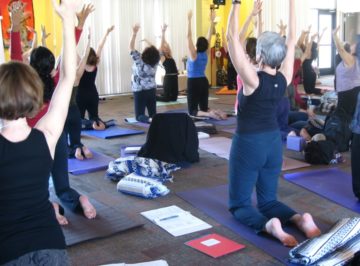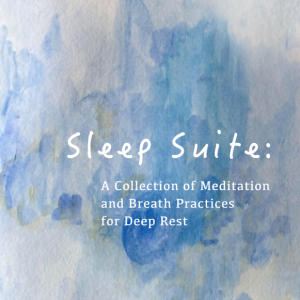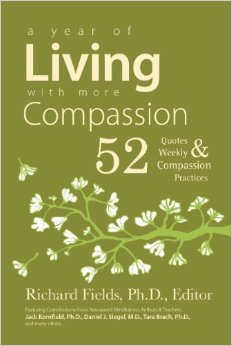At the beginning of November, I attended a memorial for my uncle Drum Hadley, cowboy, rancher, and poet. He said:
We are created in the image of the Earth. What we surround ourselves with, we become.
It set me to thinking (which my uncle would love) how much does our environment play into the ways that we feel? My uncle spent a lot of time on a ranch in Guadalupe Canyon in South Eastern New Mexico. The land is beautiful and the sky is endless and breath taking. Being there for the memorial, standing at his gravesite, I could not help but feel calm, connected, and at peace. In those moments, there was nothing to do but be present. What a joy to not be able to pick up a phone, or answer an email, or even watch TV. We talked, we hiked, we ate, we sat by a bonfire and sang songs.

As wonderful as that experience was, I write to you from the concrete-electronic jungle, in which so many of us live. I am lucky, I have a yard with a garden and a park just blocks away. So many people do not have that. But even as I walk to the park I am surrounded the hum of civilization – cars, planes, cell phones, radios, etc. If we become a product of our environments, is it any wonder that anxiety is on the rise? A morning yoga practice is a beautiful way to reconnect to our deeper selves, but that connection becomes obstructed as we move out of our practice spaces into the concrete-electronic jungle.
On my drive home from the memorial I pondered what I wanted to add to my surroundings. I added nature pictures of places that I love to my practice space and to my work space. When I work, I play music that inspires a sense of peace, calm, happiness, or joy, depending on what I need. I put my favorite essential oils into a diffuser for motivation, clarity, peace, or balance. I even bring flowers into my office. In the middle of the day, after sitting at the computer for a couple of hours, I take a walk in the neighborhood and take in a little nature. Most important are the little yoga breaks – a yoga nidra, a couple of rounds of Breath of Joy or alternate nostril, 10 minutes on the yoga mat, or a mantra – all it takes is a 10 – 20 minutes to reconnect to a deeper sense of wholeness.
We would love to hear the ways that you bring lightness and peace into your surroundings.
Namaste and thank you,
Rose
Director, LifeForce Yoga
Research: Comparing Meditation Techniques on Mental Function
This recent study published in Conscious Cognition compared the two main meditation techniques. Researchers looked at “open monitoring” meditation (OM, not to be confused with the mantra OM), which is the practice of becoming aware of our thoughts and feelings and observing them without judgment—the basis of Mindfulness Meditation. They compared OM to “focused attention” meditation (FA), an example of which is silent mantra repetition practice. Backing up previous studies, the researchers found that while both techniques enhanced executive functioning, “open monitoring” meditation may have a slight edge in enhancing attention orienting. Attention orienting is the term scientists use to indicate the mind’s ability to shift attention and refocus on the new object.
Comment: In our experience, a beginning meditator with a mood disorder accompanied by rumination and negative self-talk may find it easier to anchor the mind with a focus attention technique, like the LifeForce Yoga Chakra Clearing Meditation. After a period of practice with FA, OM may be used with a diminished risk of rumination.
https://www.ncbi.nlm.nih.gov/pubmed/27710818
Research: Yoga compared to stretching is better for the brain.
In a study to be published in December, researchers investigated what effects yoga has on the stress response, measured by changes in executive function. Executive function are cognitive processes that govern focus, inhibitory control, planning, reasoning, and problem solving. A group of 118 sedentary adults with an average age of 62 were randomized into an 8-week yoga group or a stretching control group. Self-reported stress, executive function, and salivary cortisol (stress hormones) levels were assessed at baseline and upon completion of the 8 weeks. The yoga group showed an improvement in executive function and a decrease in cortisol response. The stretching group showed poor cognitive functioning and increased cortisol levels.
Comments: The importance of this study, as mentioned by the researchers, demonstrates yoga’s ability to prevent cognitive decline in aging populations. Researchers used Hatha Yoga as the method of practice in the study, but we do not know what practices were included. To increase your cognitive functioning and executive function, go to a yoga class in your area, try one of the LifeForce Yoga DVDs, or the LifeForce Yoga Class with Rose.
https://www.ncbi.nlm.nih.gov/pubmed/27794449
Retreat Opportunities
The election season might be over, but the post election stress is eating away at relationships and sanity. Now, more than ever we need to focus on self-care, self-compassion, and compassion for others. Our retreat and trainings are a way to increase clarity, focus, and balance when we need it most. Take a weekend workshop, a 5-day, or a 7-day program to regain your center. The techniques you learn help you to ground and center on a daily basis. When you are grounded you can help others to regain their center.
Just Added! Yoga for Mood Management Retreat & Training: Module A
Feb 24 – 28, 2017 Mt. Eden Retreat Center, Washington, NJ
with Rose Kress, Debbie Lubetkin, and Kathleen Williams
More information here
Registration is ongoing, early bird rate expires 11/18
LifeForce Yoga Practitioner Training – Level 1
Jan 15 – 22, 2017 Desert Renewal Center, Tucson, AZ
with Amy Weintraub, Rose Kress, and Randy Todd
More information here
Registration is ongoing
LifeForce Yoga to Manage Your Mood
Dec 11, 2016 Yoga Connection, Tucson, AZ
with Amy Weintraub
More information here – counts as the prerequisite for the Level 1 Training
Registration
Review: Sleep Suite: A Collection of Breath and Meditation Practices for Deep Rest
Reviewed by Amy Weintraub
 Co-founder of Warriors at Ease and senior iRest Trainer, Robin Carnes has offered us a generous compilation of meditation and iRest practices designed for a good night’s sleep. It’s only in download format, because it would likely fill three or four CDs, so it’s a real bargain at $14.99.
Co-founder of Warriors at Ease and senior iRest Trainer, Robin Carnes has offered us a generous compilation of meditation and iRest practices designed for a good night’s sleep. It’s only in download format, because it would likely fill three or four CDs, so it’s a real bargain at $14.99.
I travel across multiple time zones to teach LifeForce Yoga and am often recovering from jetlag. The many practices encompassed on this compilation have been a Godsend for middle of the night awakenings.
Track One offers a nearly one hour iRest Meditation that is long on the body scan portion (Anamaya kosha). For a mind troubled by too many thoughts at bedtime, the emphasis here on body sensation can anchor the busy mind. Other tracks offer portions of a good iRest Yoga Nidra that include finding your inner resource, body sensing, breath awareness and what Robin calls, “Expanded Attention Meditation” (Anandamaya Kosha). There is also a 61 Point Meditation, popular in the Himalayan Institute yoga tradition, but used in many other traditions as well. The final track, which I have never actually reached before falling asleep, is a Coherent Breath Meditation with chimes, popularized and taught by Drs. Richard Brown and Patricia Gerbarg in their Breath-Body-Mind workshops and trainings.
If you travel a lot or suffer from insomnia, I would not hesitate to download these tracks to your listening device and keep it and your earbuds on your bedside table. I have Robin’s earlier CDs, Richard Miller’s, Jennifer Reis’s, Swami Satyananda Saraswati’s, and many others along with my own LifeForce Yoga Nidra for Mood Manage CD , and Robin’s new compilation is my current favorite.
Link to Robin’s site where you can purchase the recordings
Review: Classroom Yoga Breaks, Brief Exercises to Create Calm by Louise Goldberg
Reviewed by Ellen Campbell
 Several years ago, I reviewed Louise Goldberg’s highly informative book, Yoga Therapy for Children with Autism and Special Needs [See review in Newsletter Issue 53]. I found it to be an excellent resource for teachers, parents, and therapists, as well as a go-to guide for anyone looking to create a “curriculum of calm” for children with special needs in a home or school environment.
Several years ago, I reviewed Louise Goldberg’s highly informative book, Yoga Therapy for Children with Autism and Special Needs [See review in Newsletter Issue 53]. I found it to be an excellent resource for teachers, parents, and therapists, as well as a go-to guide for anyone looking to create a “curriculum of calm” for children with special needs in a home or school environment.
Ms. Goldberg has published a new book, Classroom Yoga Breaks, Brief Exercises to Create Calm; a work I believe deserves a spot on the bookshelves of educators and school administrators at every grade level. Louise Goldberg’s writing draws on over thirty years of Yoga Therapy experience. She is attuned to the stresses and demands that our current educational system places on children and teens, and offers a well-researched guide to help adults teach young people specific techniques for managing the emotions (anxiety, lack of focus, anger or low self-esteem, to name a few) that may arise in institutional academic settings.
Classroom Yoga Breaks is divided into five sections. Section I describes the origins of yoga and provides a valuable reminder that the postures and movements we are familiar with today are new additions to the centuries-old teachings of yoga. Louise Goldberg reminds us that the primary purpose of a yoga practice is “to prepare the body to sit in stillness, move with ease, and experience inner calm” (p.5)
Section II focuses on yoga in schools. Much of this information resonates with professional educators, as Goldberg draws parallels between her Yoga Break curriculum and such strategies as SEL (social and emotional learning) that are being implemented in many schools. Goldberg reminds us that even very short 1-5 minute yoga breaks–breathing exercises, postural movements and mindfulness activities–can effect positive change in the classroom. She addresses the various times of day when yoga breaks can be useful, including before tests, after lunch, and during transitions. She also discusses yoga as a compliment to physical education classes, anti-bullying strategies and programs for children with special needs. The final chapter of this section should not be overlooked as it discusses how to implement a yoga program within a school environment. Goldberg lays out three primary strategies and includes an important discussion regarding the education of administrators and parents as to what yoga is and is not. She also emphasizes developing the appropriate type of program for a given setting, as well as the importance of keeping lines of communication open with parents and teachers.
Section III offers an absorbing look into the intersection of neuroscience and yoga. We learn how simple movements and breath techniques can have a profound effect on our neurological state of being. Goldberg discusses current research findings that relate to yoga and the adolescent brain, as well as case studies that illuminate yoga’s ability to help with emotional regulation, mental flexibility, memory and so much more. The author provides a comprehensive overview of what is often labeled the “mind body connection” and helps us to understand the biochemical changes that occur when we are exposed to extended periods of stress.
In section IV, Goldberg lays out her Principles of Creative Relaxation; a program first implemented in 1983 that adapts yoga exercises for use in public schools and various therapeutic settings. The four principles of Creative Relaxation—to create a peaceful space, to engage the student, to provide tools for success and to foster independence—are thoroughly explored in chapters 14-17. The author gives examples of how yogic movement and breathing can support the implementation of these principles in the classroom. She also discusses how specific yoga exercises, i.e. yoga breaks, can change the mood of an individual, or the dynamic of an entire class. Examples include volcano pose as an outlet for frustration, tree pose for focus and balance, and partner poses for trust and social engagement. Instructions are provided for each of the yoga break exercises and photographs of students underscore how yoga can be enjoyed in a classroom setting without the need for yoga mats, props or fancy yoga attire!
While there is a great deal of information to absorb in Classroom Yoga Breaks, teachers and other busy adults will be pleased that Goldberg provides a complete Yoga and Mindfulness Curriculum in the fifth and final section of her book. She calls this program “Breathe First” and reminds us that it adheres to the Principles of Creative Relaxation covered in section IV. Goldberg’s Breathe First Yoga and Mindfulness Curriculum is divided into twelve units with over 200 postures and practices that can be done individually or as a series. It is a wonderful resource for teachers who may want to follow the curriculum in its entirety or for those who would rather select particular units, or even specific postures, to incorporate into the school day. LifeForce Yoga Practitioners will appreciate Goldberg’s ability to translate many familiar yoga techniques into classroom-friendly exercises. “Yoga Singing”, for example, incorporates the soothing sounds of O, Oo, Ah, A, E, M, N [used in LifeForce Yoga practices] to balance the body and open the throat area (p. 225). Goldberg’s instructions are concise and the accompanying photographs provide an additional layer of information for teachers interested in bringing yoga breaks into an academic setting. Readers will also find several useful appendixes in Classroom Yoga Breaks, Brief Exercises to Create Calm, as well as an in-depth list of references and resources.
There is much to appreciate in Louise Goldberg’s book and it is my hope that it will find its way into the hands of teachers, parents and school administrators throughout the country. With the availability of this resource, I believe we can transform the classroom experience for our youth, one breath at a time!
Review: A Year of Living with More Compassion, Second Edition, by Richard Fields, PhD (editor, co-author)
Reveiwed by Liz Payne Merideth
 Who needs more compassion? I do, and maybe you do too. So treat yourself to a copy of Richard Fields’ A Year of Living with More Compassion, second edition. It’s a lovely read, and a practical resource for anyone interested in cultivating a deeper sense of kindness, understanding, and authenticity.
Who needs more compassion? I do, and maybe you do too. So treat yourself to a copy of Richard Fields’ A Year of Living with More Compassion, second edition. It’s a lovely read, and a practical resource for anyone interested in cultivating a deeper sense of kindness, understanding, and authenticity.
Revised and updated, this guide, at 151 pages, is a compendium of insightful quotes, personal stories, and exercises that challenge the reader to reflect, week by week, on one’s own compassion. The redesigned second edition brings together 28 master teachers in the fields of mindfulness, psychology, and awareness (including Joan Halifax, Tara Brach, Daniel Siegel and LifeForce Yoga founder Amy Weintraub). Each contributor shares a much loved quote coupled with a discussion and a gentle “compassion practice” exercise to cultivate self-exploration and empathy.
Fields’ mission is to help you develop more self-compassion and compassion by shifting away from self-limiting habits. Utilize the book as you like, but it’s organized, ostensibly weekly, with 52 lessons in all. Fields has also divided the book into seven sections, each dedicated to a specific theme. The second edition has been sequenced more effectively and the new sections include, Self-Compassion; Compassion Readiness; Opening Your Compassionate Heart; Compassion & Connection; A Better Way to Deal with Reactive Emotions: Anger, Hate, Criticism, Fear; Opening Your Heart: Kindness, Generosity & Forgiveness; and Compassion & Suffering. Each lesson builds upon the last, and the collection becomes a path that walks you through an easy-to-follow program of empathy enhancement.
A Year of Living with More Compassion is an amenable handbook to help you lighten up on quiet judgment or inner criticism. The message is especially poignant, and in light of today’s social and political milieu, it goes almost without saying that this book is a timely read indeed.
Contributors
Rose Kress, ERYT-500, LFYP-2, YACEP, Director of LifeForce Yoga, author of Mantra Chanting with Rose and Pathways to Relaxation.
Amy Weintraub, MFA, E-RYT 500, C-IAYT, YACEP, founder of the LifeForce Yoga Healing Institute, the author of Yoga for Depression (Broadway Books, 2004) and Yoga Skills for Therapists: Effective Practices for Mood Management (W.W. Norton, 2012)
Ellen Campbell is a LifeForceYoga Level 1 Practitioner; she teaches yoga to children and adults in Tucson, Arizona http://www.yogawithellen.com/
Liz Payne Merideth is a soon to be RYT-200 in Tucson, AZ. She plans to teach yoga classes intended to manage moods and ease stress, and eagerly awaits LFYP Level I training in January 2017.